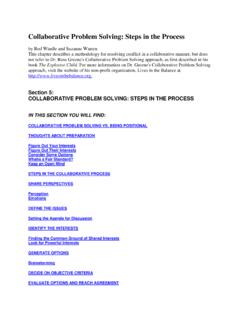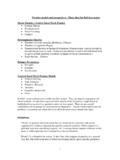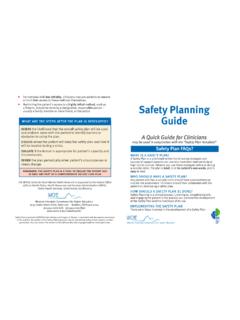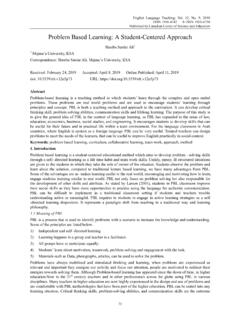Transcription of 6 Step Problem Solving Process - University of Arkansas at ...
1 The Six Step Problem Solving Model Problem Solving models are used to address the many challenges that arise in the workplace. While many people regularly solve problems, there are a range of different approaches that can be used to find a solution. Complex challenges for teams, working groups and boards etc., are usually solved more quickly by using a shared, collaborative , and systematic approach to Problem Solving . Advantages of Six-Step Problem Solving The Six-Step method provides a focused procedure for the Problem Solving (PS) group. It ensures consistency, as everyone understands the approach to be used.
2 By using data, it helps eliminate bias and preconceptions, leading to greater objectivity. It helps to remove divisions and encourages collaborative working. It stops PS groups diverging into different problems. It also helps PS groups reach consensus It eliminates the confusion caused when people use different Problem Solving techniques on the same issue. It makes the decision making Process easier. It provides a justifiable solution. All six steps are followed in order as a cycle, beginning with 1. Identify the Problem . Each step must be completed before moving on to the next step. The steps are repeatable.
3 At any point the group can return to an earlier step, and proceed from there. For example, once the real Problem is identified using 2. Determine the Root Cause(s) of the Problem , the group may return to the first step to redefine the Problem . The Six Steps 1. Define the Problem 2. Determine the Root Cause(s) of the Problem 3. Develop Alternative Solutions 4. Select a Solution 5. Implement the Solution 6. Evaluate the Outcome The Process is one of continuous improvement. The goal is not to solve but to evolve, adjusting the solution continually as new challenges emerge, through repeating the Six Step Process .
4 Step One: Define the Problem Step One is about diagnosing the Problem the context, background and symptoms of the issue. Once the group has a clear grasp of what the Problem is, they investigate the wider symptoms to discover the implications of the Problem , who it affects, and how urgent/important it is to resolve the symptoms. At this stage groups will use techniques such as: Brainstorming Interviewing Questionnaires As this step continues, the PS group will constantly revise the definition of the Problem . As more symptoms are found, it clarifies what the real Problem is. Step Two: Determine the Root Cause(s) of the Problem Once all the symptoms are found and the Problem diagnosed and an initial definition agreed, the PS group begins to explore what has caused the Problem .
5 In this step the Problem Solving team will use tools such as: Fishbone diagrams Pareto analysis Affinity diagrams These techniques help collate the information in a structured way, and focus in on the underlying causes of the Problem . This is called the root cause. At this stage, the group may return to step one to revise the definition of the Problem . Step Three: Develop Alternative Solutions Analytical, creative Problem Solving is about creating a variety of solutions, not just one. Often the most obvious answer is not the most effective solution to the Problem . The PS group focuses on: Finding as many solutions to the Problem , no matter how outlandish they may seem.
6 Looking at how each solution relates to the root cause and symptoms of the Problem . Deciding if different solutions can be merged to give a better answer to the Problem . At this stage it is not about finding one solution, but eliminating the options that will prove less effective at dealing with both the symptoms and the root cause. Step Four: Select a Solution In the fourth step, groups evaluate all the selected, potential solutions, and narrow it down to one. This step applies two key questions. 1. Which solution is most feasible? 2. Which solution is favoured by those who will implement and use it?
7 Feasibility is ascertained by deciding if a solution: Can be implemented within an acceptable timeframe? Is cost effective, reliable and realistic? Will make resource usage more effective? Can adapt to conditions as they evolve and change? Its risks are manageable? Will benefit the organization/ Which solution is favoured? Acceptance by the people who will use and implement the solution is key to success. This is where the previous steps come into play. To users and implementers, a solution may seem too radical, complex or unrealistic. The previous two steps help justify the choices made by the PS group, and offer a series of different, viable solutions for users and implementers to discuss and select from.
8 Step Five: Implement the Solution Once the solution has been chosen, initial project planning begins and establishes: The project manager. Who else needs to be involved to implement the solution. When the project will start. The key milestones What actions need to be taken before implementing the solution What actions need to be taken during the implementing the solution Why are these actions necessary? The group may use tools, such as a Gantt chart, timeline or log frame. Between Steps Five and during Step Six the operational/technical implementation of the chosen solution takes place. Step Six: Evaluate the Outcome The project implementation now needs to be monitored by the group to ensure their recommendations are followed.
9 Monitoring includes checking: Milestones are met Costs are contained Necessary work is completed Many working groups skip Step Six as they believe that the project itself will cover the issues above, but this often results in the desired outcome not being achieved. Effective groups designate feedback mechanisms to detect if the project is going off course. They also ensure the project is not introducing new problems. This step relies on: The collection of data Accurate, defined reporting mechanisms Regular updates from the Project Manager Challenging progress and actions when necessary In Step Six, as the results of the project emerge, evaluation helps the group decide if they need to return to a previous step or continue with the implementation.
10 Once the solution goes live, the PS group should continue to monitor the solutions progress, and be prepared to re-initiate the Six Step Process when it is required. Overall, the Six Step method is a simple and reliable way to solve a Problem . Using a creative, analytical approach to Problem Solving is an intuitive and reliable Process . It helps keep groups on track, and enables a thorough investigation of the Problem and solution search. It involves implementers and users, and finds a justifiable, monitorable solution based on data. You can read more about the Six-Step Problem Solving Model in our free eBook Top 5 Problem Solving Tools.

















